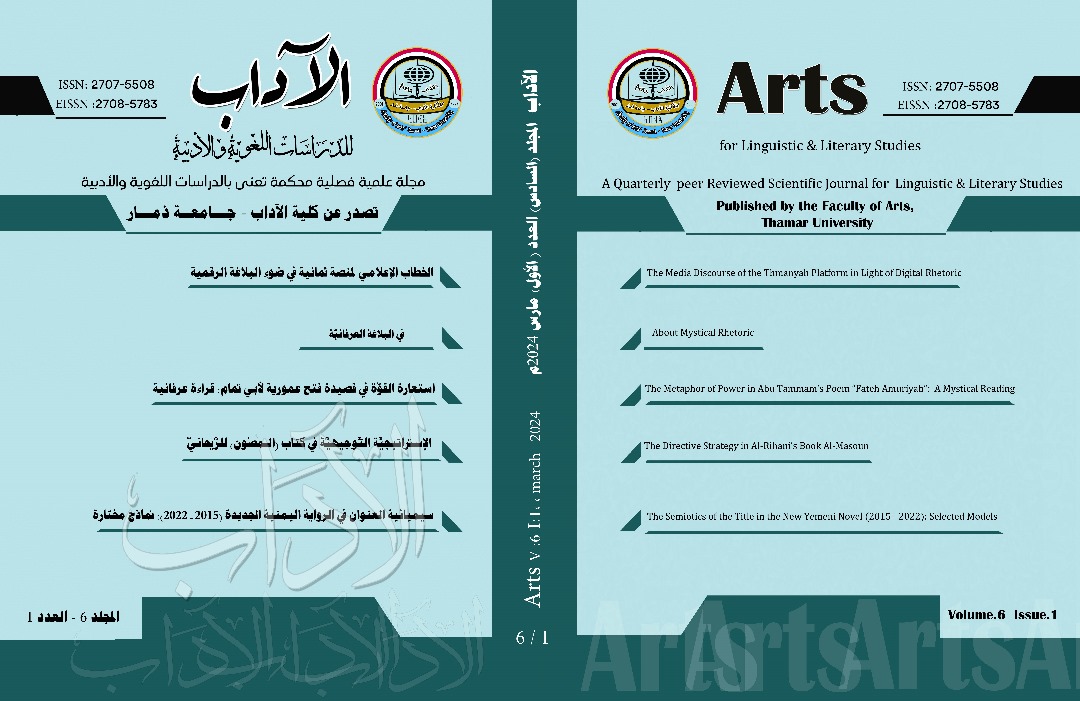الخيال التحليلي: استكشاف الخيال في الكتابات القديمة والمعاصرة
DOI:
https://doi.org/10.53286/arts.v6i1.1800الكلمات المفتاحية:
الخيال، الخيال التحليلي، الإبداع الأدبي، التفسير الأدبيالملخص
يتناول البحث مفهوم الخيال من منظور إبداعي، مع التركيز على سؤال مركزي يتعلق بمستوى سيطرة المؤلف على الطبيعة الخيالية لعمله، ذلك باستخدام منهج التحليل النصي المقارن للبحث في كتابات محددة للعثور على أوجه التشابه والاختلاف من أجل توضيح العلاقة المعقدة بين الأدب والخيال. وتم تقسيمه إلى مقدمة وجزئيين تحليليين تحت مسمى "الخيال" و"الخيال التحليلي" وخاتمة، حيث تضمنت المقدمة نبذة عن دراسات سابقة ومنهجية البحث و الأسئلة التي تطرق اليها التحليل المتعلق بالصلة بين الأدب والخيال وكيف تؤثر هذه الروابط على عملية التفسير، وتوصل إلى جملة من النتائج منها عكس تطور الفكر الرومانتيكي للخيال الشعري في العصر الحديث (كما تصورها باوند وبيكيت) و وجود ترابط بين مفهوم أرسطو للخيال و مفهوم الخيال التحليلي في العصر الحديث.
التنزيلات
المراجع
Aristotle. (1930). De anima (J. A. Smith, Trans). Psychclassics. https://psychclassics.yorku.ca/Aristotle/De-anima/index.htm (Original work published ca. 350 B.C.E)
Aristotle. (1996). Poetics (Malcolm Heath Trans.). Penguin Books. (Original work published ca. 330 B.C.E)
Babuts, N. (2011). Mimesis in a Cognitive Perspective: Mallarme, Flaubert, and Eminescu. Routledge.
Bachelard, G. (2000). The Psychoanalysis of Fire. Beacon.
Bachelard, G. (2014). The Poetics of Space. Penguin Books.
Beckett, S. (1978). Proust. Grove Press.
Beckett, S. (1983). An imaginative work!. In R. Cohn (Ed.) Disjecta: Miscellaneous Writings and a Dramatic Fragment (pp. 89–90). John Calder.
Coleridge, S. T, (1817). “Biographia Literaria.” Gutenberg. https://www.gutenberg.org/files/6081/6081-h/6081-h.htm#link2HCH0013
Hacker, p (2010). Human Nature: The Categorial Framework. Wiley-Blackwell.
Ipsen, G. (2009) The value of literature: the disparity between 'Practical Criticism' and 'Modern Literary Theory' with a case study of Thomas Hardy [Doctoral thesis, University College London]. University of London Research Repository. https://discovery.ucl.ac.uk/id/eprint/17277/
Kast, V. (2014). Complexes and imagination. The Journal of Analytical Psychology, 59(5), 680–694. https://doi.org/10.1111/1468-5922.12113
Kemal, S. (1988). Medieval Arabic Poetics: Poetic Syllogism and Community in Avicenna’s Commentary on Aristotle’s Poetics. Philosophy Research Archives, 14(1), 20–122. https://doi.org/10.5840/PRA1988/198914SUPPLEMENT35
Kiesselbach, D. (2012). Salt Pier. University of Pittsburgh Press.
Kim, J. (2006). Piagetian and Vygotskian Perspectives on Creativity. The International Journal of Creativity and Problem Solving, 16(1), 25–38. G704-000413.2006.16.1.008
Knowlson, J. (1996). Damned to Fame: The Life of Samuel Beckett. Bloomsbury.
Koopman, E. & Hakemulder, F. (2015). Effects of Literature on Empathy and Self-Reflection: A Theoretical-Empirical Framework. Journal of Literary Theory, 9(1), 79–111. https://doi.org/10.1515/jlt-2015-0005
Marshall, D. G. (1982). Ideas and History: The Case of “Imagination.” Boundary 2, 10(3), 343–359. https://doi.org/10.2307/302801
Mooij, J. (1993). Fictional Realities: The uses of literary imagination. John Benjamin Publishing Company.
Oatley, K. (1995). A taxonomy of the emotions of literary response and a theory of identification in fictional narrative. Poetics, 23(1-2), 53–74. https://doi.org/10.1016/0304-422X(94)P4296-S.
O’Brien, J. (1993). Reasoning with the Senses: The Humanist Imagination. South Central Review, 10(2), 3-19. https://doi.org/10.2307/3189996
Pagels, E. (1988). Adam, Eve, and the Serpent. Random House.
Pardales, M. (2002). "So, How Did You Arrive at that Decision?" Connecting Moral Imagination and Moral Judgement. Journal of Moral Education, 31(4), 423–437. https://doi.org/10.1080/0305724022000029653.
Reinert, O. (2010). Ibsen and Mimesis. Scandinavian Studies, 82(2), 213–230. https://doi.org/10.2307/40908164.
Pickvance, C. (2001). Four varieties of comparative analysis. Journal of Housing and the Built Environment, 16(1), 7–28. https://doi.org/10.1023/A:1011533211521.
Pound, E. (1951). ABC of Reading. Faber and Faber.
Riffaterre, M. (1984). Intertextual Representation: On Mimesis as Interpretive Discourse. Critical Inquiry, 11(1), 141–162. https://doi.org/10.1086/448279
Rundell, J. (2001). Imaginary Turns in Critical Theory: Imagining Subjects in Tension. Critical Horizons, 2(1), 61–92. https://doi.org/10.1163/156851601750170007.
Schaverien, J. (2007). Countertransference as active imagination: imaginative experiences of the analyst. The Journal of Analytical Psychology, 52(4), 413–31. https://doi.org/10.1111/J.1468-5922.2007.00674.X.
Smith, A. (1976). The Theory of Moral Sentiments ( D.D. Raphael and A.L. Macfie Eds.). Indianapolis: Liberty Classics.
Steadman, J. M. (1998). Image-Making in the Verbal and Visual Arts: A Renaissance Obsession. Huntington Library Quarterly, 61(1), 53–80. https://doi.org/10.2307/3817622
St. Armand, B. L. (1975). A Superior Abstraction: Todorov on the Fantastic [Review of The Fantastic: A Structural Approach to a Literary Genre, by T. Todorov & R. Howard]. NOVEL: A Forum on Fiction, 8(3), 260–267. https://doi.org/10.2307/1345108
Wordsworth, W. (1800). “Lyrical Ballads, with Other Poems, 1800, Volume 1.” Gutenberg. https://www.gutenberg.org/cache/epub/8905/pg8905.html.
التنزيلات
منشور
كيفية الاقتباس
إصدار
القسم
الرخصة

هذا العمل مرخص بموجب Creative Commons Attribution 4.0 International License.
:حقوق الطبع والنشر والترخيص
يحتفظ الباحثون بحقوق النشر. ويتم ترخيص البحوث بموجب ترخيص Creative Commons CC BY 4.0 المفتوح، مما يعني أنه يجوز لأي شخص تنزيل البحث وقراءته مجانًا. وإعادة استخدام البحث واقتباسه شريطة أن يتم الإشارة إلى المصدر الأصلي. تتيح هذه الشروط الاستخدام الأقصى لعمل الباحث وعرضه.



